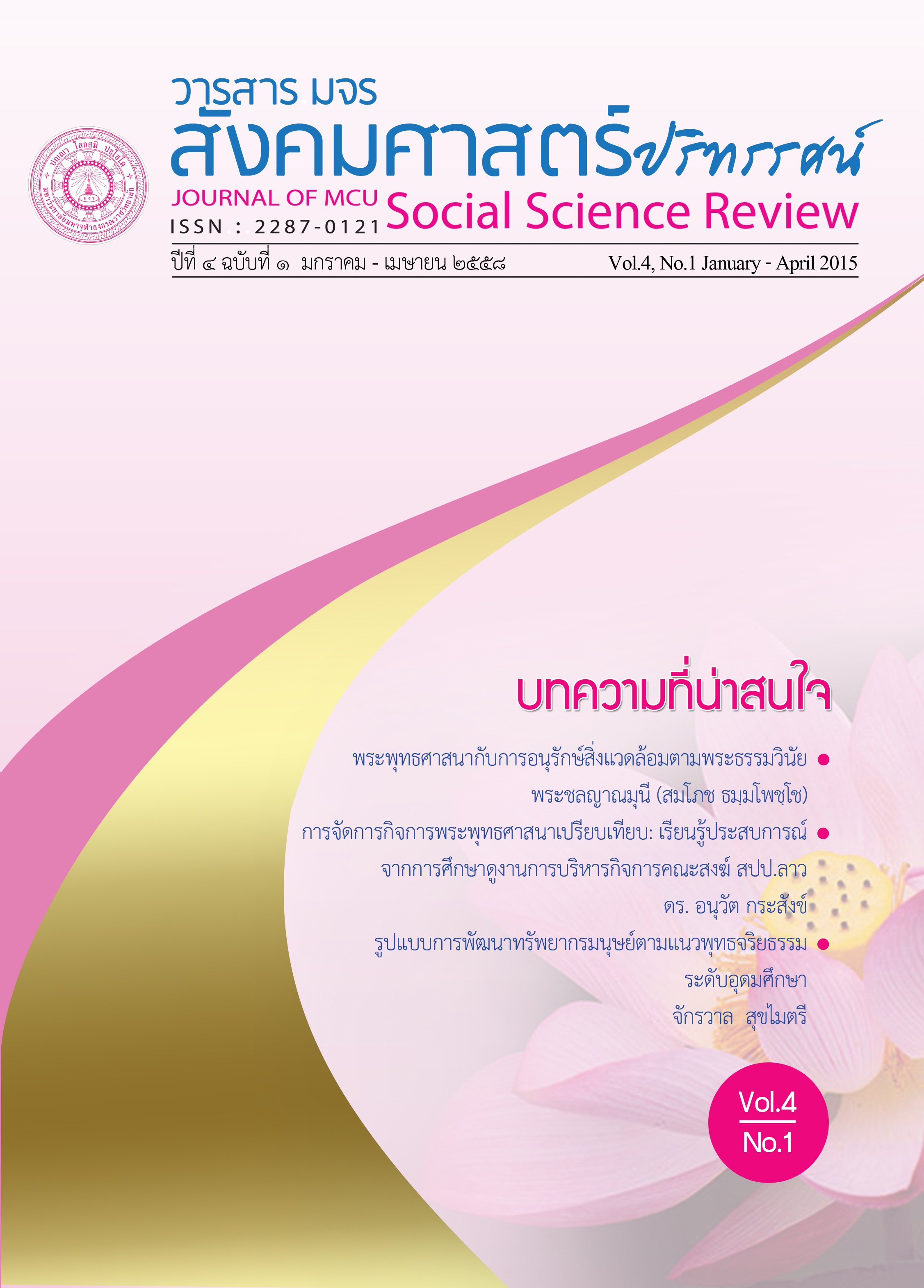รูปแบบการพัฒนาทรัพยากรมนุษย์เชิงพุทธของมหาวิทยาลัยราชภัฏ ภาคเหนือตอนล่าง ๒
คำสำคัญ:
รูปแบบ, การพัฒนาทรัพยากรมนุษย์บทคัดย่อ
งานวิจัยฉบับนี้ มีวัตถุประสงค์คือ (๑) เพื่อศึกษาสภาพทั่วไปของการพัฒนาทรัพยากร มนุษย์สายวิชาการมหาวิทยาลัยราชภัฏภาคเหนือตอนล่าง ๒ (๒)เพื่อศึกษาการพัฒนาทรัพยากร มนุษย์เชิงพุทธของมหาวิทยาลัยราชภัฏภาคเหนือตอนล่าง ๒ และ (๓) เพื่อนําเสนอรูปแบบการ พัฒนาทรัพยากรมนุษย์เชิงพุทธของมหาวิทยาลัยราชภัฏภาคเหนือตอนล่าง ๒ ระเบียบวิธีวิจัยเป็นแบบผสานวิธี (Mixed Methods Research) ระหว่างการวิจัยเชิง ปริมาณ ใช้การศึกษาวิจัยเชิงสํารวจ กําหนดกลุ่มตัวอย่างจากบุคลากรสายวิชาการของมหาวิทยาลัย ราชภัฏภาคเหนือตอนล่าง ๒ คือ มหาวิทยาลัยราชภัฏนครสวรรค์ และ มหาวิทยาลัยราชภัฏ กําแพงเพชร จํานวน ๒๐๐ คน เก็บข้อมูลด้วยแบบสอบถามแบบประมาณค่า ๕ ระดับ ที่มีค่าความ เชื่อมั่น ด้านการพัฒนาทรัพยากรมนุษย์ของมหาวิทยาลัยราชภัฏภาคเหนือตอนล่าง ๒ เท่ากับ เท่ากับ ๐.๔๓ และ ด้านการพัฒนาทรัพยากรมนุษย์ตามหลักไตรสิกขาเท่ากับ 0.๔๕ วิเคราะห์ข้อมูล ด้วยสถิติ ค่าความถี่ ค่าร้อยละ ค่าเฉลี่ย ค่าส่วนเบี่ยงเบนมาตรฐาน การวิจัยเชิงคุณภาพ โดยการเก็บ ข้อมูลจากการสัมภาษณ์เชิงลึก จากผู้ให้ข้อมูลสําคัญ จํานวน ๑๙ ท่าน ซึ่งเป็นนักวิชาการ จากนั้นนํา ผลวิจัยมาสังเคราะห์เป็นรูปแบบเบื้องต้น แล้วนําเสนอต่อเวทีการสนทนากลุ่มเฉพาะ จาก ผู้ทรงคุณวุฒิจํานวน ๑๐ ท่าน เพื่อยืนยันรูปแบบการพัฒนาทรัพยากรมนุษย์เชิงพุทธของ มหาวิทยาลัยราชภัฏภาคเหนือตอนล่าง ๒
ผลการวิจัยพบว่า ๑. สภาพทั่วไปของการพัฒนาทรัพยากรมนุษย์สายวิชาการของมหาวิทยาลัยราชภัฏ ภาคเหนือตอนล่าง ๒ ในด้านการฝึกอบรมมีนโยบายการจัดการอบรมบุคลากรเชิญวิทยากรทั้ง ภายในและภายนอกมาอบรม ในด้านการศึกษา สนับสนุนการศึกษาต่อของบุคลากรในระดับที่สูงขึ้น เพื่อเพิ่มศักยภาพในการทํางาน และในด้านการพัฒนา มีการส่งเสริมและสนับสนุนให้บุคลากร พัฒนางานของตนเองพัฒนาให้บุคลากรมีความรู้ความสามารถ ส่วนการพัฒนาทรัพยากรมนุษย์ตาม ลักษณะ ๕ ด้านคือ ด้านบุคลิกภาพด้านวิชาการ ด้านทักษะด้านเจตคติด้านความคิดสร้างสรรค์ นั้น บุคลากรควรมีบุคลิกภายนอกที่ดี และเป็นแบบอย่างที่ดี มีความเป็นผู้นําทางวิชาการ บุคลิกภายใน ต้องเป็นคนที่มีจิตใจที่ดีงาม มีเจตคติที่ดี เป็นคนใจเย็น อารมณ์ดี มีทัศนะคติที่ดี มองโลกในแง่ดี
๒. การพัฒนาทรัพยากรมนุษย์เชิงพุทธของมหาวิทยาลัยราชภัฏภาคเหนือตอนล่าง ๒ ด้านศีล ได้ส่งเสริมให้บุคลากรมีความรับผิดชอบต่อหน้าที่การงานอย่างเต็มที่มีการจัดอบรมถือศีล และปฏิบัติธรรมประจําปีการฝึกอบรมขั้นศีล คือ ฝึกกายวาจา ขั้นสมาธิ คือ ฝึกจิตใจ ขั้นปัญญา คือ ฝึกองค์ความรู้ในการพัฒนาด้านสมาธิ มีการส่งเสริมให้บุคลากรทําสมาธิให้จิตใจมีความสงบสุขก่อน ปฏิบัติงานอยู่เสมอด้านปัญญาสนับสนุนให้บุคลากรปฏิบัติงาน โดยใช้หลักความเห็นชอบ และคิด ชอบในการทํางาน
๓. รูปแบบการพัฒนาทรัพยากรมนุษย์เชิงพุทธของมหาวิทยาลัยราชภัฏภาคเหนือ ตอนล่าง ๒ พบว่า การพัฒนาทรัพยากรมนุษย์ในด้านศีล (B = Behavior) การพัฒนาเน้นไปที่การ พัฒนาพฤติกรรมทางกายและวาจาการพัฒนาทรัพยากรมนุษย์ด้านศีลก่อให้เกิด ทักษะ และมี บุคลิกภาพที่ดี การพัฒนาทรัพยากรมนุษย์ด้านสมาธิ หรือ การพัฒนาจิตใจ (M = Mind) การพัฒนา ทรัพยากรด้านสมาธิยังก่อให้เกิด เจตคติที่ดีในการทํางานการพัฒนาด้านปัญญา หรือ การพัฒนาด้าน ความรู้ (W = Wisdom) เป็นการพัฒนาทรัพยากรมนุษย์ในขั้นสูงสุดและมีความสําคัญสูงสุดปัญญา นํามาใช้กับความรู้ทางวิชาการ และความคิดสร้างสรรค์ เพราะต้องให้เกิดความรับรู้ และจะต้องมี ความคิดสร้างสรรค์จะได้รูปแบบจากการสังเคราะห์ (Synthesis Model) การพัฒนาทรัพยากร มนุษย์เชิงพุทธ BuddhistHuman Resource Development คือ BHRD = BMW
เอกสารอ้างอิง
(๑) หนังสือ :
กรมวิชาการ. การศึกษากับการพัฒนาทรัพยากรมนุษย์/พระธรรมปิฎก (ป.อ. ปยุตโต), กรุงเทพมหานคร: พิมพ์ลักษณ์, ๒๕๓๙.
เกื้อจิตร ชีระกาญจน์. การพัฒนาทรัพยากรมนุษย์, กรุงเทพมหานคร : โรงพิมพ์มหาวิทยาลัยธุรกิจบัณฑิตย์, ๒๕๕๑.
พระธรรมปิฎก (ป.อ. ปยุตโต), ธรรมะกับการทํางาน. พิมพ์ครั้งที่ ๓. กรุงเทพมหานคร สํานักพิมพ์มูลนิธิพุทธธรรม, ๒๕๔๓.
มัลลี เวชชาชีวะ. การพัฒนาทรัพยากรมนุษย์ กรุงเทพมหานคร: สานักวิจัยสถาบันพัฒนาบัณฑิตบริหารศาสตร์, ๒๕๒๔.
(๒) วิทยานิพนธ์ :
กุลชลี พวงเพ็ชร์, “กลยุทธ์การพัฒนาทรัพยากรมนุษย์ของธุรกิจประกันภัยในประเทศไทย : ศึกษาเฉพาะกรณีการฝึกอบรม” วิทยานิพนธ์ปรัชญาดุษฎีบัณฑิต (บริหารธุรกิจ) บัณฑิตวิทยาลัย : มหาวิทยาลัยรามคําแหง, ๒๕๕๐.
ฌาน ตรรกวิจารณ์ “การพัฒนาทรัพยากรมนุษย์เชิงพุทธ” วิทยานิพนธ์ปรัชญาดุษฎีบัณฑิต. บัณฑิตวิทยาลัย: มหาวิทยาลัยรามคําแหง, ๒๕๕๐.
ณัฐพงษ์ ไพจิตรธนโชติ “รูปแบบการพัฒนาบุคลากรทางการสอนในกลุ่มสาระการเรียนรู้การงานอาชีพและเทคโนโลยีกลุ่มโรงเรียนจุฬาภรณราชวิทยาลัย วิทยานิพนธ์การศึกษาดุษฎี บัณฑิต (บริหารการศึกษา), บัณฑิตวิทยาลัย: มหาวิทยาลัยนเรศวร, ๒๕๔๘.
(๓) วารสาร
อนุวัต กระสังข์, “ผู้นําในยุคโลกาภิวัตน์”, วารสาร มจร สังคมศาสตร์ปริทรรศน์, ปีที่ ๓ ฉบับที่ ๒ (พฤษภาคม-สิงหาคม ๒๕๕๗).
๒. ภาษาอังกฤษ
(1) Book :
Adranam H. Maslow. “A Theory of Human Motivation”. (Psychological Review. 50, 1943.
Bardo J.W. and Hardman J.J. Urban Sociology : A Systematic introduction. NewYok: F.E. Peacock Publishers, 1982.
Cronbach, Lee J. Essentials of psychological testing (4" ed.) Cunnighan,W.G.. &Cordeiro,P.A. .Educational Administration : A Problem - Based Approach.Bostos : Allyn and Bacon, 2000.
Dessler, Gary. Human Resource Management, ed. New York : McGraw -Hill, 2003.
ดาวน์โหลด
เผยแพร่แล้ว
รูปแบบการอ้างอิง
ฉบับ
ประเภทบทความ
สัญญาอนุญาต
ลิขสิทธิ์ (c) 2018 วารสาร มจร สังคมศาสตร์ปริทรรศน์

อนุญาตภายใต้เงื่อนไข Creative Commons Attribution-NonCommercial-NoDerivatives 4.0 International License.
เพื่อให้เป็นไปตามกฎหมายลิขสิทธิ์ ผู้นิพนธ์ทุกท่านต้องลงลายมือชื่อในแบบฟอร์มใบมอบลิขสิทธิ์บทความให้แก่วารสารฯ พร้อมกับบทความต้นฉบับที่ได้แก้ไขครั้งสุดท้าย นอกจากนี้ ผู้นิพนธ์ทุกท่านต้องยืนยันว่าบทความต้นฉบับที่ส่งมาตีพิมพ์นั้น ได้ส่งมาตีพิมพ์เฉพาะในวารสาร มจร สังคมศาสตร์ปริทรรศน์ เพียงแห่งเดียวเท่านั้น หากมีการใช้ภาพหรือตารางหรือเนื้อหาอื่นๆ ของผู้นิพนธ์อื่นที่ปรากฏในสิ่งตีพิมพ์อื่นมาแล้ว ผู้นิพนธ์ต้องขออนุญาตเจ้าของลิขสิทธิ์ก่อน พร้อมทั้งแสดงหนังสือที่ได้รับการยินยอมต่อบรรณาธิการ ก่อนที่บทความจะได้รับการตีพิมพ์ หากไม่เป็นไปตามข้อกำหนดเบื้องต้น ทางวารสารจะถอดบทความของท่านออกโดยไม่มีข้อยกเว้นใดๆ ทั้งสิ้น





